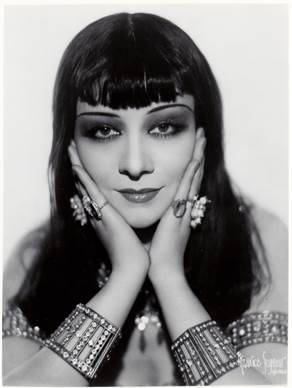
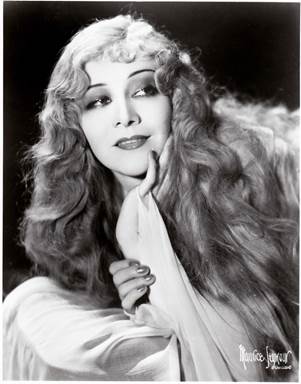 (as Amneris and Venus, collection Charles Mintzer)
(as Amneris and Venus, collection Charles Mintzer)COE GLADE REMEMBERED (1900- 1986) by Charles Mintzer

 (as Amneris and Venus, collection Charles Mintzer)
(as Amneris and Venus, collection Charles Mintzer)
Coe Glade is an American original. In her day she was one of the most highly acclaimed young American singers who very early went to the top of her profession at the Chicago Civic Opera, and after that company folded in 1932 during the Depression she criss-crossed the North American continent singing her unique Carmen and other mezzo-soprano roles in virtually every medium size and large city for a score of years. For a generation this artist, blessed with the beauty and glamour of a movie star and the spunk of a barnstormer, was so closely identified with the Bizet heroine that when those who heard her reflect back on their Carmens she is very often at the top of their affectionate remembrance.(Click here for Martin Bernheimer's memories of her Carmen)
Sadly Coe Glade never made commercial recordings; we have no substantial professionally recorded documentation of her voice in her prime, only the prestige of the company she kept and the companies that kept her. This amazingly vital woman who sang with the likes of Claudia MUZIO, Mary GARDEN, Rosa RAISA, Edith MASON, Frieda LEIDER, Eva TURNER, Maria OLSZEWSKA, Charles MARSHALL, Antonio CORTIS, José MOJICA, Giovanni MARTINELLI, Tito SCHIPA, Jan KIEPURA, Cesare FORMICCHI, Richard BONELLI, John Charles THOMAS, VANNI-MARCOUX and Alexander KIPNIS among others, can still, at the mere mention of their legendary names, conjure up in a few words, with devastating precision, what they were really like vocally and artistically. We can safely assume that this woman who rose to stardom at the Chicago Opera possessed an important voice and a developed vocal artistry stamped with her uniquely American personality.
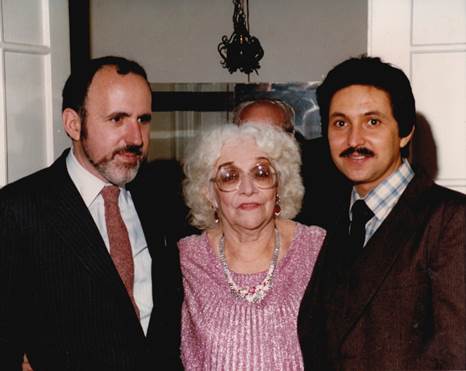 (Charles Mintzer, Coe Glade and Eli Solis, NYC 1983)
(Charles Mintzer, Coe Glade and Eli Solis, NYC 1983)
Born in Chicago in 1900 (for publicity reasons she shaved off six years and said 1906) and raised in her teens in Tampa, Florida, Coe Glade at a very early age was an accomplished pianist and dancer; she states she got the opera “bug” in 1925 while summering with her family near Chicago and attending many performances at the Ravinnia Festival. Martinelli, Danise, Raisa, Bori and Schipa were among her first inspirations for the operatic stage. After more intensive studies with Homer Moore, she auditioned for Fortune Gallo’s touring San Carlo Opera while in Asheville, North Carolina. She was immediately accepted and made her debut as Amneris that autumn with the San Carlo in Montreal. A few weeks later, barely 21 years old, she was singing Amneris in “Aida” in New York City with Clara Jacobo at the Century Theatre on September 16, 1926. In 1928 she was engaged by the Chicago Civic Opera, making her debut on November 10, 1928 in a Saturday evening “Aida” with Hilda Burke, Charles Marshall, Robert Ringling (scion of the Barnum circus family) and Alexander Kipnis with Henry Weber conducting. In quick succession she was Siebel in “Faust” with Edith Mason, Charles Hackett and Kipnis; Marina in “Boris Godunov” with Vanni-Marcoux, Antonio Cortis (Dmitri), Mojica (Shuisky) and Virgilio Lazzari (Pimen); Roesweisse in a “Walküre” that featured Leider (Brünnhilde), Turner (Sieglinde), Olszewska, Forrest Lamont, and Kipnis as Wotan. Her first Carmen with the Chicago was the December 23rd matinee with Alice Mock, René Maison and Cesare Formicchi; Polacco conducting. Edward Moore in the Tribune stated : “She is the kind of Carmen that makes the lights seem to be turned up a bit when she comes on stage, and the music to sound a little more golden”.
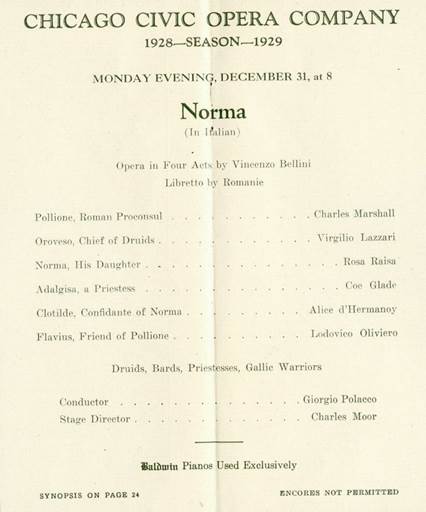
By all accounts, THE event of that season was the New year’s Eve “Norma” marking the re-entry to the company of Rosa Raisa who had earlier taken maternity leave but miscarried, and was returning to Chicago to participate in the last month of performances in the old Auditorium before this company moved to the new opera house on Wacker Drive. Polacco assigned Glade the role of Adalgisa just nine days before the premiere. Not only did she have to learn from scratch this demanding role written in a style totally different from anything she had done previously, but she had to find in the few rehearsals allotted the correct blending and balancing of her voice with the mighty Raisa instrument. History has recorded that performance one of opera’s legendary evenings; Coe Glade garnering excellent notices for her stunning vocalism, acting and sheer pluck—singing difficult fioritura and alternating high C’s with Raisa. Marshall and Lazzari completed the cast; Polacco conducted “pressing the last drop of ecstasy out of Bellini’s score”. (1)
Coe Glade participated in several notable revivals and presentations between 1929 and 1932 while on the roster of the Chicago Civic, including :
Dulcinee in “Don Quichotte” with Vanni-Marcoux and Edward Cotrieuil; Emil Cooper
Maddalena in “Rigoletto” with Margherita Salvi, Charles Hacket, Giovanni Inghilleri, Lazzari; Frank St. Leger
Laura in “La Gioconda” with Rosa Raisa, Ada Paggi, Charles Marshall, Cesare Formicchi, Chase Baromeo; Emil Cooper
Venus in “Tahnnhäuser” with Raisa, Marshall, Bonelli, Baromeo; Polacco
Pantalis in “Mefistofele” with Claudia Muzio, Cyrena van Gordon (Helen of Troy), Antonio Cortis, Alexander Kipnis; Roberto Moranzoni
Julie in “Camille” (by Hamilton Forest) with Mary Garden, Charles Hacket, Theodore Ritch, Barre Hill, Baromeo; Cooper (note: world premiere, Garden’s last creation)
“Mignon” (title role) with Salvi, Jennie Tourel, Tito Schipa, Baromeo; Cooper
Annina in “Der Rosenkavalier” with Frieda Leider, Marie Olszewska, Thelma Votipka, Kipnis; Egon Pollak
Azucena in “Il Trovatore” with Iva Pacetti, Cortis, Augusto Beuf, Lazzari; Moranzoni
Hoo-Chee in “L’Oracolo” with Vanni-Marcoux, Lazzari, Salvatore Baccaloni, Serafina de Leo, Moranzoni
Nancy in “Martha” with Leola Turner, Tito Schipa, Baccaloni; St. Leger
Lola in “Cavalleria Rusticana” with Muzio, Cortis, Beuf; Isaac van Grove
This idyllic world collapsed in February 1932 while on tour in Boston when the Chicago Civic opera terminated its performances under the accumulated weight of the Depression and utility magnate and opera Croesus Samuel Insull’s massive financial and legal troubles. Coe Glade sang in the Civic’s next to last performance, Saturday matinee, February 13, 1932 – “Mignon” with Salvi, Hackett, Vanni Marcoux; Cooper.
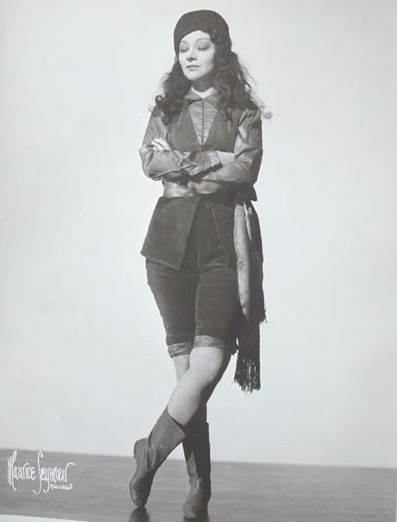 (in Mignon, courtesy Charles Mintzer)
(in Mignon, courtesy Charles Mintzer)
After a hiatus of one year grand opera returned to Chicago, but never on the exalted level or with the unique individuality of the old Chicago Civic. Renamed the Chicago City Opera, presented shorter seasons, no tours, and a company scrambled together from the available singers of the old Chicago Civic, the Metropolitan and other companies. Coe Glade was part of these seasons and had her share of triumphs.
Some samples of notable casts in which she participated:
1934 : “TANNHÄUSER” : Lotte Lehmann, Paul Althouse; Henry Weber
1937 : “CARMEN” : Hilde Burke, José Luccioni; Louis Hasselmans
“NORMA” : Gina Cigna, Martinelli, Pinza; Samuel Samosoud
“MARTHA” : Schipa, Mason, Rimini; Bigalli
1941 : “CARMEN” : Kirsten, Rayner, Morelli; Carlo Peroni
“AIDA” : Rethberg, Martinelli, George Czaplicki, Lazzari; Emil Cooper
1942 : “IL TROVATORE” : Rose Bampton, Martinelli, Bonelli; Bigalli
“CARMEN” : Jan Kiepura, Morelli; Alexander Smallens
Simultaneous with her work at the Chicago City opera, Coe Glade’s career had taken a new direction; heavy concert tours (some years as many as 90 appearances) on the Civic concert circuit, summer opera in Cinicinatti (as she sang there for more than 20 seasons her own very special city) and after 1937 ten more years of touring the North American continent with the Fortune Gallo San Carlo opera. Although the San Carlo, as a popular priced touring company, did not have the prestige of the Chicago or the Metropolitan, its few singers of Coe Glade’s caliber gave this enterprise a vitality and professionalism that on many occasions produced highly memorable and artistic evenings.
Some of the artists of particular interest to record collectors who sang with the San Carlo company during Glade’s association were :
Henri Scott, Tomaso Alcaide, Marguerite Sylva, Anne Roselle, Aroldo Lindi, Carlos Ramirez, Maru Castagna (Bruna’s sister), Carmela Ponselle, James Melton, Marie Powers, Norina Greco, Gertrude Ribla, Elizabeth Wysor, Mario Berini, Hilda Reggiani, Tina Paggi, Pau Civil, Vivian della Chiesa, Graziela Rivera and many others. Cardell Bishop’s history of the San Carlo covers this era with substantial detail.
Some of the highlights of Coe Glade’s career were her participation in the gargantuan programme that opened Radio City Music Hall during the Christmas week of 1932. The Wallendas, The Roxyettes, Martha Graham and her company, Vera Schwarz of the Vienna State opera in her American debut singing Johann Strauss, Ray Bolger, the Tuskegee Institute Choir and a 40 minute abridged version of “Carmen” with Coe Glade, Aroldo Lindi and Titta Ruffo in some of the very last operatic appearances of his career.
After her complete retirement of the stage in 1963, and even before when partially retired, Glade had forged a second and successful career as a voice teacher in Manhattan. Several of her pupils have made notable names in both classical and popular music. Tommy Tune, the musical star - was amongst them. Glade died in NYC in 1985 and was memorialized in a simple protestant service. Another of her students, Luise Lanzelotti sang the Ave Maria.
In our youtube channel –we write 1983 - Coe Glade shares with us some of her memories and special insights into her era. This remarkable woman who scaled the heights and went on to become Middle America’s favorite Carmen has a message. She is not a jaded woman who believes that the best was all in the past.
NOTE ON THE VIDEO INTERVIEW
In 1983, making a video of an event such as the Coe Glade interview was not as easy as it is today. A VRCS member, George Henderson, rented a video camera and was able to tape 25-30 minutes, the beginning of the program. Another member of the organization, whose name I don’t know, taped the program with a hand-held tape recorder from several feet away, and another member of the organization gave me the cassette with most of the remainder of the program. As Coe made no commercial recordings herself, I obtained from the late Andy Karzas of Chicago, dubs of radio checks from the 1930 and 1940s. These radio checks had been copied several times over the years and this accounts for the less-than-ideal sound.
I had met and interviewed Coe Glade several times at her New York apartment on West 73rd Street and Amsterdam Avenue. Therefore I knew very well her stock of stories and anecdotes. In order to have a free-flowing conversation that would elicit her stories we (Arthur Naftal and Eli Solis) did not prepare a printed program; instead the late Arthur Naftal, who had a world-class 78rpm record collection, prepared individual cassettes with the selections we would offer, but did not know the order, or if time constraints would mean some of the prepared selections could not be offered. Therefore the order was relatively spontaneous. In lieu of a printed program I prepared a twenty-plus page handout with biographical information and photos of the very photogenic lady.
In my notes, I did not know, in 1983, a wonderful story that Coe told me about a year later. It seems that The Washington Opera gave a performance of “Carmen” at the Kennedy Center, and the next day several senators were discussing the performance in the senate dining room. Senator Mark Hatfield, Republican senator from Oregon, expressed the opinion that the best Carmen he ever saw over the years was that beautiful and sexy Coe Glade with the touring San Carlo Opera Company in Portland, Oregon. He wondered what ever happened to her. A staff aide located her in New York and he telephoned her to reminisce about that performance and to wish her good health. Coe was very touched.
Click here to see our youtube clip with the filmed interview !!!!!!!
Click here for the second part!!!!!
Click here for her obituary in the New York Times
(1) quote from Edward Moore’s 40 Years of opera in Chicago